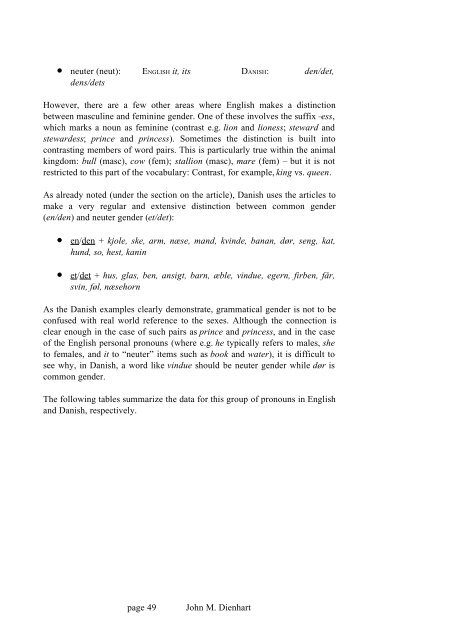Download - VISL
Download - VISL
Download - VISL
Create successful ePaper yourself
Turn your PDF publications into a flip-book with our unique Google optimized e-Paper software.
• neuter (neut): ENGLISH it, its DANISH: den/det,<br />
dens/dets<br />
However, there are a few other areas where English makes a distinction<br />
between masculine and feminine gender. One of these involves the suffix –ess,<br />
which marks a noun as feminine (contrast e.g. lion and lioness; steward and<br />
stewardess; prince and princess). Sometimes the distinction is built into<br />
contrasting members of word pairs. This is particularly true within the animal<br />
kingdom: bull (masc), cow (fem); stallion (masc), mare (fem) – but it is not<br />
restricted to this part of the vocabulary: Contrast, for example, king vs. queen.<br />
As already noted (under the section on the article), Danish uses the articles to<br />
make a very regular and extensive distinction between common gender<br />
(en/den) and neuter gender (et/det):<br />
• en/den + kjole, ske, arm, næse, mand, kvinde, banan, dør, seng, kat,<br />
hund, so, hest, kanin<br />
• et/det + hus, glas, ben, ansigt, barn, æble, vindue, egern, firben, får,<br />
svin, føl, næsehorn<br />
As the Danish examples clearly demonstrate, grammatical gender is not to be<br />
confused with real world reference to the sexes. Although the connection is<br />
clear enough in the case of such pairs as prince and princess, and in the case<br />
of the English personal pronouns (where e.g. he typically refers to males, she<br />
to females, and it to “neuter” items such as book and water), it is difficult to<br />
see why, in Danish, a word like vindue should be neuter gender while dør is<br />
common gender.<br />
The following tables summarize the data for this group of pronouns in English<br />
and Danish, respectively.<br />
page 49<br />
John M. Dienhart
















